
 .
.
Within 30 minutes of two planes hitting the World Trade Center twin towers, American Airlines Flight 77 departed Dulles International Airport bound for Los Angeles. The Boeing 757 was hijacked and crashed, loaded with 10,000 gallons of fuel, at 345 mph into the west side of the Pentagon. The five-story Pentagon is made up of five pentagonal structures arranged in concentric rings. These rings surround a five-acre open courtyard and are connected by 10 spike-like corridors. The plane took out light poles in the parking lot, hit the ground just outside the outermost ring of the Pentagon, turned up on its wing, and penetrated the E ring (outermost) midway between corridors 4 and 5 as shown below. It then traveled through the D ring and into the C ring. CNN has some good footage from a security camera that captured the plane striking the ground.

Diagram of the impact and damage
(Graphic courtesy of The Washington Post)
|
Aerial view before the attack |
Arial view after the attack |
| (Pictures courtesy of spaceimaging.com. Permission is granted to publish in hard copy, broadcast and electronic media, provided proper attribution is given for each and every use. Click here for terms and conditions.) | |
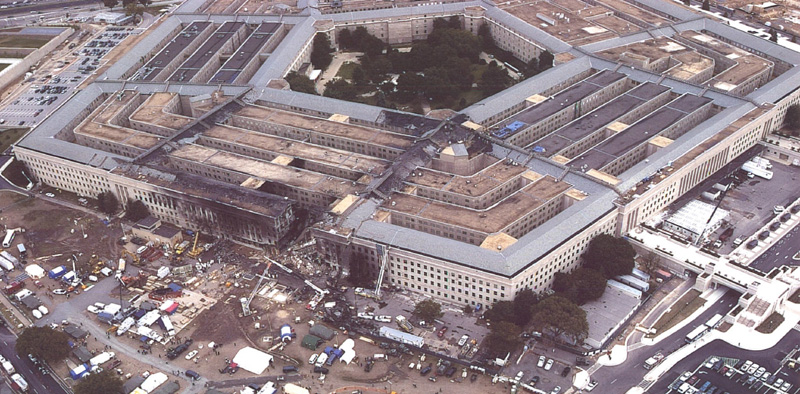
Impact site
All 58 passengers, four flight attendants, and both pilots on board, as well as 125 occupants of the Pentagon, died. Although the blast from the plane and the toxic gas and heat from the resulting fire killed some people in their offices near the crash site, some people working inside the Pentagon that morning did not know that a plane had hit their building. Military and civilian personnel running up and down the corridors yelling for people to get out helped to save a lot of lives. It was estimated that there were close to 2,600 people working in the Pentagon near the impact site. The fact that so many people were able to survive speaks well to the design of Pentagon. Indeed, the building received many upgrades following the Oklahoma City bombing to protect it from similar terrorist attacks. For instance, a recently completed $258 million renovation to the west wing included Kevlar-reinforced windows. Despite the impact of the plane and the fires, the damaged area did not collapse for 30 minutes, and the windows just next to the impact site remained intact, as shown below.
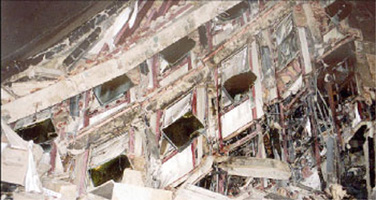 The web of 6-by-6-inch steel columns held the structure of the outer wall of the Pentagon together. |
 Blast-resistant windows on either side of the impact area remained intact above the second floor. |
Shortly after the plane crashed into the Pentagon, the Arlington County Fire 1 Department requested aid from the District of Columbia (DC) Fire/EMS Department. Because the incident commander had a plane crash, building fire, terrorist attack, building collapse, and a crime scene all going on at once, the District dispatched a second alarm 2 assignment to the Pentagon, along with several EMS units. A little less than an hour later, Prince George's County Fire and EMS Department (PGFD) put out a call for all volunteer and career personnel to report to their stations. Being a volunteer firefighter with Greenbelt's Volunteer Fire Department and Rescue Squad for almost 6 years, I reported to my station. As units from DC were enroute to the Pentagon, the DC Fire Chief called back all DC fire personnel. The Chief also requested mutual aid from Prince George's and Montgomery Counties Fire Departments to fill in at stations in the Nation's Capital that were sent to the Pentagon. Shortly after 11:00 am, engines 3 from Greenbelt, Morningside, Kentland, and Branchville and a truck 4 from Cottage City were transferred into the District. Greenbelt's Chief, Assistant Chief, six other personnel, and I filled in at DC Engine 8 (1520 C Street) in southeast DC. Because we were not familiar with southeast DC, an officer from Station 8 rode with us on our engine. Shortly before 12:30 pm, we ran a hazardous materials call at a local high school. Enroute to the call, we could not help but wonder if this was part of the terrorist attack. We cleared the call almost 30 minutes later. Just after 1:00 pm, the DC Fire Department's Pentagon Command requested a third alarm. As we were heading back to Station 8 in the District, we were informed that we were being transferred to another DC fire station. Arriving at Station 8, we dropped off the officer who was riding with us. Just as we were about to leave, he ran out telling us that we were the first due on the third alarm at the Pentagon.
All transferred companies from PG were placed on the third alarm. As we were driving down the freeway responding to the Pentagon, it looked like a war zone—military vehicles and busses carrying personnel, police cruisers, and Red Cross and other disaster vehicles all rushing past; helicopters in the air; and not an airplane or passenger vehicle in sight. When we arrived at the Pentagon, we stood by in the south parking lot so that we could meet with DC fire officials and review the plan of attack. The fires were still burning, and thick black smoke filled the air.
|
Greenbelt's Fire Chief following a fire engine from Branchville responding to the third alarm at the Pentagon |
(Photo courtesy of BBC News) |
Because the access tunnel leading underneath the Pentagon to the inside courtyard was only 10-foot 2-inch high, many of the towers and ladder trucks that were to go to the courtyard to put water on the roof were too tall to fit through the tunnel. Therefore, some of these apparatus had their roofs cut off so that they would fit through the tunnel. While the first and second alarms were attacking the fire from the exterior of the outer ring, at 1:25 pm, the third alarm units proceeded through the tunnel into the inner courtyard. The idea was to attack the fire from inside the Pentagon, pushing it from the unburned areas back into the burnt areas.
What we found when we entered the inner courtyard was unbelievable. Large groups of military and emergency room doctors were milling about waiting for survivors to be brought out of the building. Parts of the airplane and building were thrown about the courtyard and marked with evidence flags. FBI and other federal officials were walking around conducting their investigation. Members of the military were standing by at a makeshift morgue with body bags waiting for the fires to be put out so that search-and-rescue crews could go in and recover bodies of the victims. Over 35 agencies responded to the Pentagon that day.
There was a lot of misinformation that moved across the courtyard, and we felt very isolated from the events that were going on outside the walls of the Pentagon — reports of thousands of civilians and 500 firefighters feared dead at the collapse of the World Trade Center towers, a plane crashing into Camp David, a bomb exploding at the State Department, and that the military had information that 50 other targets were to be hit that day. Although some believed that there was the possibility of additional terrorist attacks on the Pentagon, we knew all we could do was focus on the task at hand.
Shortly after 2:00 pm, our first task was to stand by outside the B ring while the Arlington Fire Department attempted to make entry to the first floor between corridors 4 and 5. The fire was too intense and the crew quickly retreated.
Around 3:00 pm, the units from Prince George's County were then given the unenviable task of taking the first interior attack line into the C ring of the second floor of the Pentagon with the express orders to search for survivors and extinguish what fire we could. It had been determined that this was the area most likely to have survivors. If no survivors were found, extinguishing the fires would allow search-and-rescue crews to follow behind and begin to recover bodies. A 4" supply line (yellow in the picture below) was laid by the Arlington County Fire Department from outside the Pentagon into the inner courtyard. We entered corridor 5 and proceeded to the second floor of the C ring, stretching a 3" line (tan in the picture below) from an engine from Branchville. My task was to carry one of two 1-3/4" attack lines (red in the picture below) that were to be deployed to attack the fires. We advanced the supply line approximately 200 feet down the first floor of Corridor 5 through the A ring, into the B ring, and up an interior stairwell to the second floor. Once crews reached the second floor, the 3" supply line was stretched another 200 feet into the C ring. At that point, I hooked up one of the two attack lines and our crew made an attempt to extinguish the fires on the second floor.
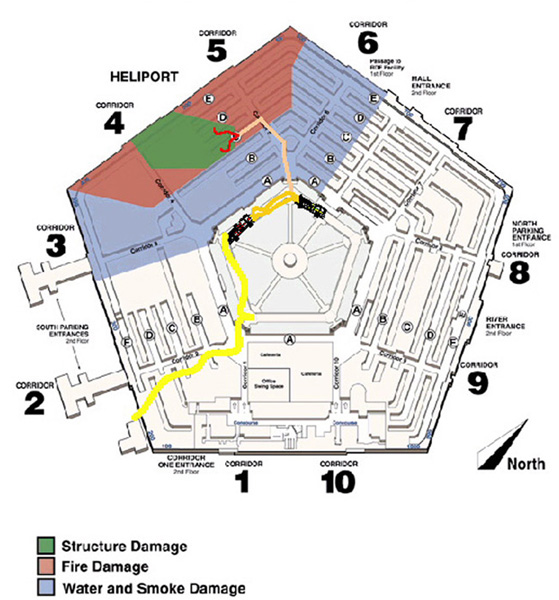
(Graphic courtesy of the Morningside Volunteer Fire Department)
There was fire on all five floors and the air was smoky and hot. The floor tiles were literally "popping" off the floor out of the water due to the intense heat of the fires burning on the floor beneath us, and some of the water was turning into steam. Ceiling had fallen and ventilation systems dangled down. While working our way through the building, we encountered extreme fire conditions, numerous fatalities, and unfortunately no survivors. The devastation was unbelievable. We found an inch or so of water on almost every floor. The hallways were dark and some were smoked filled while others had the fire alarms still sounding.
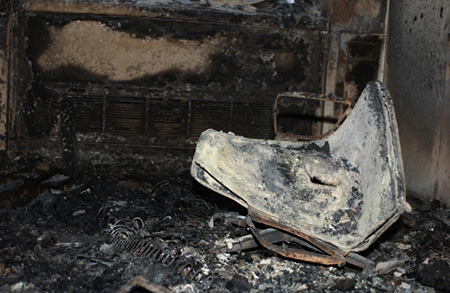
A fire-damaged chair lies inside an office on the fourth floor of the Pentagon
(Photo courtesy of the U.S. Department of Defense: Photo number 010914-F-4692S-008)
In a few locations, we came across golf carts that were still running. It was apparent that these common modes of transportation around the Pentagon on this day became escape vehicles. After exhausting our breathing apparatus, we were physically and mentally drained. We returned to the outside and immediately refilled our bottles.
A lieutenant from the U.S. Navy, who was inside the west side of the Pentagon when the plane hit and helped get some people out that morning, advised us that there was the possibility of survivors in a communications bunker on the fourth floor of the E ring. Because the bunker is where workers were informed to retreat in the case of an attack on the building, the lieutenant requested that an attempt be made to locate the bunker. Because he felt a need to help save his brothers and sisters and because he knew the layout of the Pentagon better than any of us, he donned firefighting clothes and the breathing apparatus of an injured firefighter (a piece of debris was lodged in his eye). We re-entered the Pentagon and, following his lead, attempted to reach the fourth floor. Unfortunately the bunker had not survived the initial impact of Flight 77.
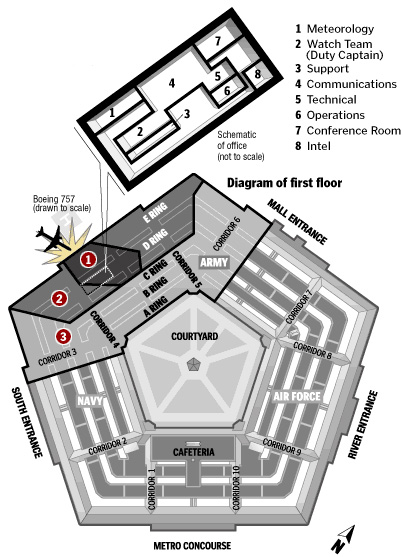
Navy Command Center
(Graphic courtesy of washingtonpost.com)
After a much-needed rest outside the building, we were asked to make another entry into the C ring of the second floor to extinguish a fire that had flared up in this area. Just as we were gathering outside corridor 5 to review our plans, a dozen or so military officers were coming in our direction. There was a tall gentleman that stood out above the rest of the crowd. As they got closer, I recognized the gentleman as General Hugh Shelton, the Chairman of the Joint Chiefs of Staff. He told the DC battalion chief in charge of our operation that he wanted to go in and inspect the damage. The chief quickly explained to General Shelton that he was not allowed to enter the building. After he and his group left, we entered the building. Because we had ventilated portions of the offices by breaking windows during our first attack on the fire, this area was cooler and much of the smoke had dissipated, making it easier to search for hidden fires. In addition to finding portions of walls still burning, we found fire inside filing cabinets and desk drawers. We divided up into two crews. While we were sitting in the hallway waiting for the attack crew to extinguish as much fire as they could before their breathing air was depleted, one of the rookies commented that this was his first fire. We reminded him that the fires he runs in the future would not all be this big. Another member of our crew reflected on the events of the day and how he hoped that the United States would respond to this attack. The DC firefighter from Station 8 who was with us stopped the crewmember mid-sentence to remind us that all we should think about for the next hour or so is what is at the end of the hall and to focus on our objective. He said there would be plenty of time to reflect upon the events of the day after we were home alive.
After spending just over seven hours at the Pentagon (close to three hours of which were actual firefighting duties) and making four separate forays into the building, we were relieved by off-duty firefighters from Arlington County, Alexandria City, and the District who had been recalled to duty.
Many people have asked me over the past year what it was like to be at the Pentagon on September 11th. One of the hardest things to deal with was seeing people's offices just as they had left them that morning—keys and pictures of their families on their desks and newspapers and coffee cups still sitting around. I realized that 125 of those people did not make it out alive. The gravity of the day really hit me as we were walking to the facilities that the Red Cross and other relief agencies had set up in the parking lot. As I walked by the cars in the lot, I could not help but wonder how many of them belonged to those Pentagon workers who had lost their lives that day. They came to work just as they have every other day, unaware of what was about to happen.
Additional information on the Pentagon and the terrorist attacks of September 11th can be found at:
1 The Pentagon lies within the boundaries of Arlington County, Virginia.
4 A "truck" carries ladders and no hose.
DISCLAIMER: I do not speak for any of the organizations listed on these pages.
© 2001-2025 Brian J. Roberts
Last updated: 19 November 2024